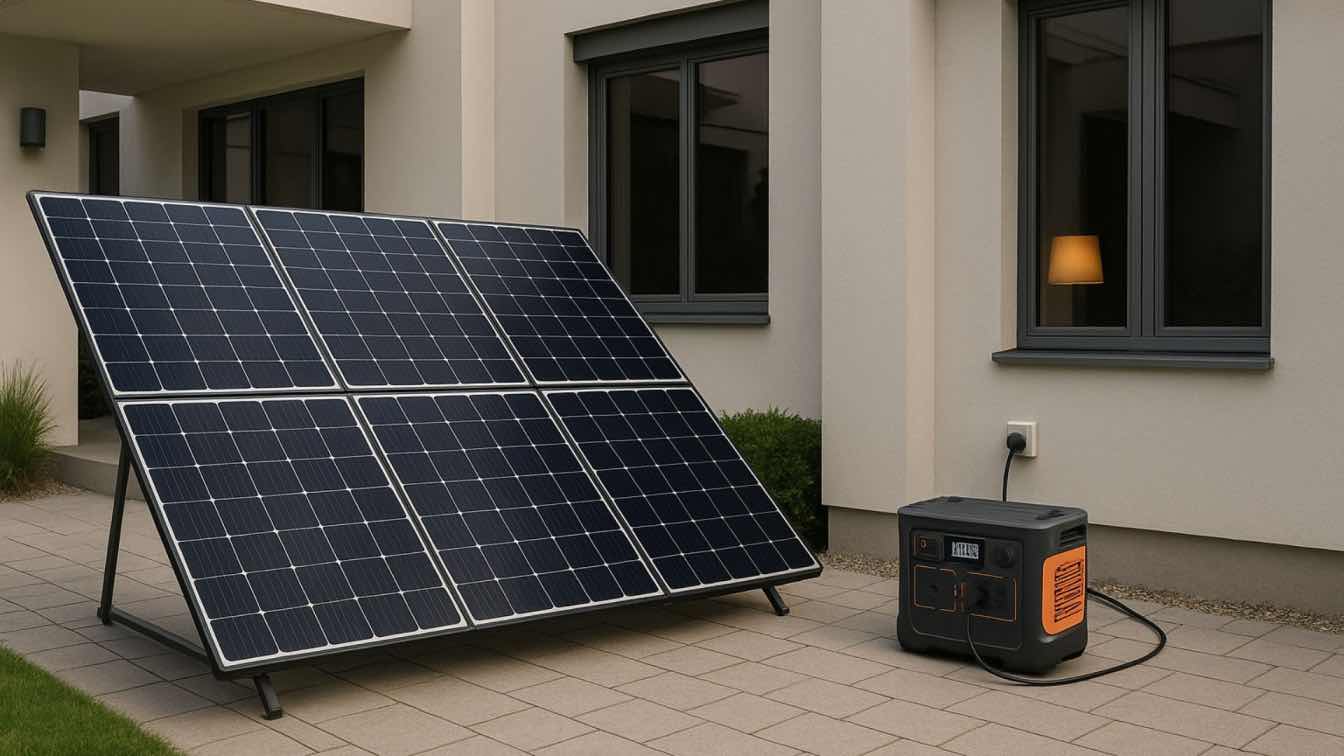When the lights suddenly go dark and your home falls silent, the impact of a power outage becomes all too real. As extreme weather events increase nationwide, these disruptions are becoming more frequent and prolonged, leaving homeowners vulnerable. Traditional backup solutions like gas generators are increasingly falling short of modern needs, creating a critical gap in home resilience. Enter solar generators – a revolutionary approach to power backup that combines clean energy with reliable performance. These innovative systems offer homeowners a powerful trifecta: efficient power delivery, environmental responsibility, and unprecedented ease of use. By harnessing solar energy and advanced battery technology, these systems provide peace of mind without the noise, fumes, and maintenance headaches of conventional generators. As we explore the world of solar backup power, you'll discover how these smart solutions are transforming home energy security for the modern era.
Understanding Modern Power Outage Challenges
The landscape of power reliability in America is rapidly changing, with extreme weather events pushing our aging electrical grid to its limits. In 2023 alone, major weather disasters caused over 300 significant outages across the country, affecting millions of households. These disruptions expose critical vulnerabilities in our homes – from spoiled food and interrupted medical devices to compromised security systems and failed sump pumps. While traditional gas generators have long served as backup solutions, they're increasingly proving inadequate for modern needs. Their dependence on fuel supplies, mechanical maintenance requirements, and outdoor-only operation create significant limitations during extended outages. The average American household now experiences 2-3 extended power outages annually, with some regions facing outages lasting 24-72 hours. Climate scientists predict this trend will worsen, with a projected 50% increase in weather-related outages by 2030. This new reality demands more reliable, sustainable backup power solutions that can seamlessly integrate with our increasingly electrified homes while providing consistent, long-term protection against grid instability.
Solar Generators: How They Revolutionize Backup Power
Solar generators represent a significant leap forward in backup power technology, combining three essential components into a seamless energy solution. At their core, solar panels capture sunlight and convert it into DC electricity through photovoltaic cells. This power flows into advanced battery storage systems, typically utilizing lithium iron phosphate (LiFePO4) chemistry for superior longevity and safety. The final component, a smart inverter, transforms stored DC power into AC electricity that your home appliances can use. This integrated system operates with remarkable efficiency, converting up to 23% of solar energy into usable power – a significant improvement over traditional energy sources. Unlike conventional generators, solar systems operate silently and produce zero emissions, eliminating common concerns about noise pollution and carbon monoxide. Their modular nature allows for easy capacity expansion, enabling homeowners to start with basic coverage and scale up as needs grow. Modern solar generators can power everything from essential medical equipment to entire home circuits, with some systems capable of supplying up to 40kW of continuous power. The technology's rapid advancement has also dramatically improved charging speeds, with some units able to reach 80% capacity in under an hour when combining solar and AC charging. This combination of clean operation, scalability, and rapid charging capability makes solar generators an increasingly attractive option for homeowners seeking reliable backup power solutions.
Compact Power Stations: Your Home's First Defense
Why Size and Portability Matter
Modern homes face increasing space constraints, making compact power solutions essential for emergency preparedness. Portable solar generators offer unmatched flexibility, fitting easily in closets, garages, or utility rooms without sacrificing valuable living space. Their lightweight design proves invaluable during evacuations or when power needs shift between different areas of your home. Unlike traditional generators that must remain outdoors, these indoor-safe units can be positioned wherever power is needed most, from keeping medical devices running in bedrooms to powering refrigerators in kitchens, all without harmful emissions.
Innovative Solutions in Action
Leading manufacturers like EcoFlow are revolutionizing portable power technology, delivering exceptional performance in compact form factors. Advanced battery management systems support simultaneous charging of up to 10 devices through multiple output ports, including USB-A, USB-C, and standard AC outlets. Modern units feature boost technology that enables powering devices up to 2400W while maintaining stable output. Real-world testing demonstrates their ability to run essential appliances like refrigerators for 8-12 hours on a single charge. Through smart app integration, users can monitor power consumption, adjust charging parameters, and receive maintenance alerts in real-time. UL2743 and ETL certifications ensure the highest safety standards, while expandable battery designs allow capacity upgrades without replacing the base unit.
Implementing Your Power Outage Solution
Step-by-Step Setup Guide
Setting up your solar generator system begins with strategic panel placement. Position solar panels where they receive maximum sunlight exposure, typically south-facing with a 30-45 degree tilt. For optimal charging, avoid partial shade from trees or structures. Once positioned, connect the solar panels to your generator using the provided MC4 cables, ensuring weatherproof connections. Before first use, charge your unit to 100% using both AC power and solar input. Create dedicated circuits for essential devices by mapping out your power needs and connecting them through the appropriate ports. Test each connection individually, verifying stable power delivery through the system's display panel. For medical devices, establish redundant power paths and clearly label all connections for quick access during emergencies.
Maintenance for Peak Readiness
Maintaining your solar generator ensures reliable performance when you need it most. Store batteries at 50-80% charge in a cool, dry environment, ideally between 50-70°F. Conduct monthly capacity checks by running a full charge-discharge cycle. Clean solar panels quarterly using a soft brush and mild soap solution, paying special attention to edge seals and connection points. Keep panel surfaces free from debris, snow, or leaves that could reduce charging efficiency. Update your generator's firmware regularly through the manufacturer's app to access the latest features and security improvements. Before storm seasons, complete a comprehensive readiness check: verify all ports function correctly, test automatic switching capabilities, and ensure backup batteries hold their charge. Create a troubleshooting guide covering common issues like charging interruptions or output fluctuations, keeping it accessible for all family members.
Choosing Your Optimal Solar Generator
Selecting the right solar generator starts with a detailed power needs assessment. Calculate your essential load by listing critical appliances and their wattage requirements - refrigerators typically need 100-250 watts running power, medical devices 50-200 watts, and lighting circuits 200-500 watts depending on home size. For comprehensive coverage, add a 20% buffer to account for startup surges and future needs. Battery chemistry plays a crucial role in long-term reliability; LiFePO4 batteries offer superior cycle life exceeding 3500 charges and maintain stable performance across temperature extremes, unlike traditional lithium-ion cells that degrade faster. When evaluating portability versus capacity, consider your specific scenario - apartment dwellers might prioritize compact units under 30 pounds, while homeowners with dedicated storage space can opt for larger systems offering extended runtime. Brand reliability extends beyond warranty terms; examine the manufacturer's service network, spare parts availability, and firmware update frequency. Future-proofing your investment means choosing systems with expandable capacity, standardized connection ports, and robust smartphone integration. Look for models supporting multiple charging methods, including AC, solar, and car charging, to ensure power access in various scenarios. The ideal system should align with your five-year home energy plan, accounting for potential EV adoption, home office needs, or medical equipment requirements.
Empowering Your Home's Energy Future
As power outages become increasingly common in our climate-challenged world, solar generators represent a crucial evolution in home energy security. These systems fundamentally transform how we approach backup power, offering unmatched reliability without the environmental impact of traditional solutions. The technology's rapid advancement delivers the perfect balance of power capacity, portability, and user-friendly operation. Through smart features, expandable capabilities, and zero-emission operation, these systems provide homeowners with unprecedented control over their energy security. The time to prepare for power disruptions is before they occur – and today's solar generators make that preparation both accessible and effective. By assessing your power needs and implementing a solar backup solution, you're not just protecting your home from outages; you're investing in a cleaner, more resilient energy future. Take the first step toward energy independence by evaluating your home's backup power requirements and exploring how a solar generator can transform your approach to power security.





